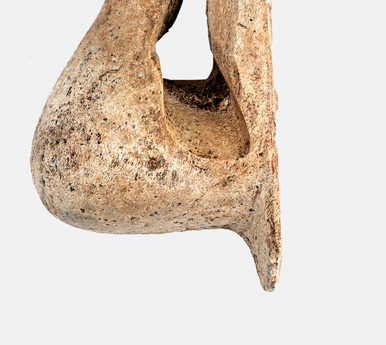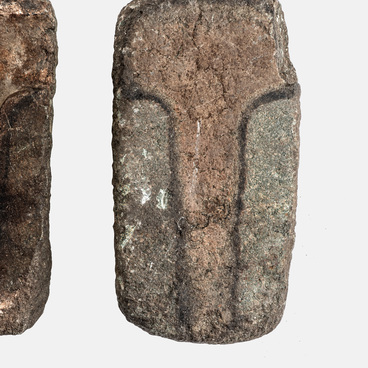The settlement of Krivoye Ozero (Kokry-Kul, Nagaybakskoye) is located on the left bank of the Gumbeika River, 3.8 kilometers southeast of the village of Fère-Champenoise. In the course of the excavations of the settlement, a casting mold for three objects — a knife and two pieces of jewelry — was found among other items.
The soapstone mold is a single panel in the form of a flat rectangular bar. One end is flat, while the corners on the other end are rounded. The negative impressions of the products are present on both side planes.
One of them has an incised negative impression of a fragment of a knife blade with a part of the handle. The guard is designed in the form of sloping spurs. A longitudinal groove — the edge of the future product — is cut through the center along the entire length of the impression. The impression is vertically shifted to the side edge of the mold. A blind round hole (0.6 centimeters in diameter) is drilled between the side edge of the mold and the negative impression of the product (near the shoulders). On the rounded corner on the opposite side of the mold surface, there is a through round hole with a diameter of 0.6 centimeters.
On the second lateral plane there are two carved negative impressions of jewelry (clasps) identical in shape and size and consisting of two circles connected by crossbars. Two circles are carved in the discs, with a deep rounded notch in the center. The crossbars have the form of deep grooves, at the bottom of each are three deep recesses, one is rounded, the other is oblong. A sprue funnel is carved into each impression from the flat end. On the side of the impression, a narrow straight groove is carved along the entire piece. On the rounded end there is a shallow cross-cut.
The negative impressions of the clasps were carved after the soapstone panel with the knife/dagger mold was broken. The clasps were two rounded discs of 11.5–12 millimeters in diameter connected by a 3-millimeter-wide rod. The disks and the rod were formed in the same plane. The total length of the product was 33–34 millimeters. The possible thickness of the metal is from 2 to 3 millimeters. There are three protrusions on the connecting rods, obviously for better clamping of the connected edges of fabric or leather. Such clasps could be used as cufflinks.
Similar casting molds were found at the settlement
of Staro-Kumlyakskoe I in the Plastovsky district. However, they are rare
specimens — rods connected in pairs like cufflinks. More similar items and
related decorative motifs can be found among jewelry in the Caucasus or in
Troy.



